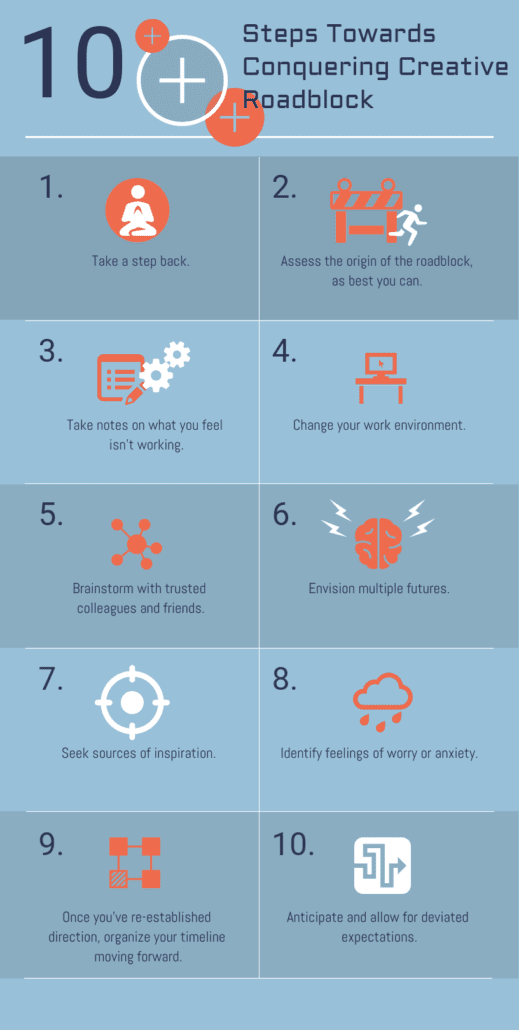Building a brand is a constant, ongoing process of creating, reevaluating and adjusting – of identifying when one idea is working and soldiering on when another is not. When that process comes to a sudden halt and you fall into a frustrating rut, turn towards this ten-step process as a guide in overcoming creative roadblocks.
- Take a step back.
The moment you recognize that a project isn’t going as hoped for can feel deeply discouraging. At the same time that discouragement actively works against the creative process, allowing those feelings to run their course is equally as important. Step away from your projects to see what gives you a sense of calm: a walk, music, cooking, or simply reaching out to a friend.
2. Assess the origin of the roadblock, as best you can.
At this stage, it may be difficult to see how to move forward without first giving yourself a chance to examine what went awry. Try to identify the moment the tide began to turn: what were you initially trying to achieve, and when did this goal start to feel further away?
3. Take notes on what you feel isn’t working.
Even if you don’t typically journal, experiment with putting your thoughts into words. Avoid assigning blame and focus on identifying what has you stuck. Even if writing doesn’t generate new ideas straightaway, it creates a record, for future reference, of avenues that haven’t been productive.
4. Change your work environment.
If you work from home, try removing yourself for the time being to create some distance between spaces of work and rest. If you typically work from an office, a more comfortable space could “take the edge” off of impending deadlines.
5. Brainstorm with trusted colleagues and friends.
For those of you tackling a task solo, talk through your roadblock with people you trust in and out of your immediate work environment. The patience and ingenuity of a fresh pair of ears can nudge you in an unexpected direction.
6. Envision multiple futures.
Oftentimes, creative blocks originate from the idea that one perfect, better-than-the-rest solution necessarily exists. Using some practices mentioned above—handwriting thoughts or talking to a trusted friend—try returning to the place of excitement that had you feeling motivated at the start. Envisioning what the result of your efforts could and will be fuels the activation energy needed to hit ‘restart’ on your project.
7. Seek sources of inspiration.
Creative ruts can be defined as the absence of inspiration. Building something from scratch can be exhausting, and it comes at the cost of feeling motivated from within. Can you turn towards models of excellence or novelty for what you’re working to accomplish—without doing yourself the unkindness of wondering why you haven’t already reached that point yourself?
8. Identify feelings of worry or of anxiety.
Even after we take a walk, consult our friends, and brainstorm a new batch of solutions, there can be a latent worry that our success is outside of our control. This is a natural part of clawing our way through being stuck, and it helps to compassionately identify worrying as a part of what holds us back.
9. Once you’re re-established direction, organize your process moving forward.
You’re almost out of the muck—you’re regenerated a sense of excitement around your project and have a general sense of where you’re headed next. If it helps streamline your process, ‘sketch out’ what the following days or weeks look like for you. Breaking down chunks of time into digestible morsels can feel like turning on your bright headlights while driving at night.
10. Anticipate and allow for change.
As you already know from the experience of creative block itself, plans can veer off-course. The largest part of anticipating and armoring ourselves against the frustrations of being stuck is to leave time and energy to recover from the inevitable moment something happens unexpectedly—and to work towards the lifelong task of embracing the creative potential in these moments.

